Principality of Lippe
Lippe (later Lippe-Detmold and then again Lippe) was a historical state in Germany, ruled by the House of Lippe. It was located between the Weser river and the southeast part of the Teutoburg Forest.
Principality of Lippe Fürstentum Lippe | |||||||||
|---|---|---|---|---|---|---|---|---|---|
| 1123–1918 | |||||||||
 Flag
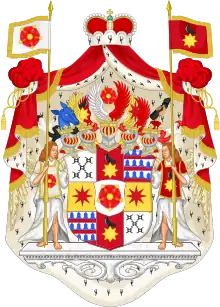 Coat of arms
| |||||||||
.svg.png.webp) The Principality of Lippe within the German Empire | |||||||||
| Status | State of the Holy Roman Empire (1123–1806) State of the Confederation of the Rhine (1806–1813) State of the German Confederation (1815–1866) State of the North German Confederation (1867–1871) Federated State of the German Empire (1871–1918) | ||||||||
| Capital | Detmold | ||||||||
| Common languages | West Low German | ||||||||
| Religion | Church of Lippe | ||||||||
| Government | Principality | ||||||||
| History | |||||||||
• Established | 1123 | ||||||||
• Raised to County | 1528 | ||||||||
• Raised to Principality | 1789 | ||||||||
• German Revolution | 12 November 1918 | ||||||||
| |||||||||
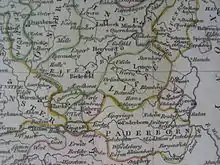
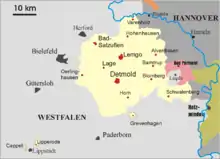
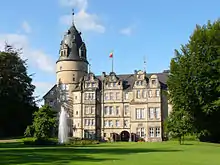

History
The founder of what would become the County of Lippe (1528–1789), then the Principality of Lippe (1789–1918) was Bernhard I, who received a grant of territory from Lothair III in 1123. Bernhard I assumed the title of Edler Herr zu Lippe (noble Lord to Lippe). The history of the dynasty and its further acquisitions of land really began with Bernard II. His territory was probably formed out of land he acquired on the destruction of the Duchy of Saxony following the demise of Henry the Lion in 1180. From 1196 to 1666 the descendants of Bernard II passed their holdings from father to sons for sixteen generations. Thereafter until 1905, a collateral branch passed Lippe from father to sons for eight generations. A distant relation then became the last ruler until the Revolution of 1918 when Lippe became the Free State of Lippe.[1] Simon V was the first ruler of Lippe to style himself as a count (Graf) in 1528.[2]
Following the death of Simon VI in 1613, the county was partitioned between his three sons; Lippe-Detmold went to Simon VII, Lippe-Brake to Otto and Lippe-Alverdissen went to Philip I. The county of Lippe-Brake was reunited with the main Detmold line in 1709. Another branch of the family was founded by Jobst Herman, a son of Simon VII, who was founder of the Lippe-Biesterfeld line.[2] From this branch, the branch Lippe-Weissenfeld was later to be separated. Both were so-called paragiums (non-sovereign estates of a cadet-branch) within the County of Lippe. Both branches, owning only modest manor houses in the county, acquired property in other states by marriage and moved out of the county in the late 18th century, the Biesterfeld branch to the Rhineland, and the Weissenfeld branch to Saxony.
The Counts of Lippe-Detmold were granted the title of Imperial prince in 1789.[2]
Shortly after becoming a member state of the German Empire in 1871, the Lippe-Detmold line died out on 20 July 1895. This resulted in an inheritance dispute between the neighbouring principality of Schaumburg-Lippe and the Lippe-Biesterfeld line. The dispute was resolved by the Imperial Court in Leipzig in 1905, with the lands passing to the Lippe-Biesterfeld line who, until this point, had no territorial sovereignty.[2]
The Principality of Lippe came to an end on 12 November 1918 with the abdication of Leopold IV, with Lippe becoming a Free State. In 1947, Lippe merged into the state of North Rhine-Westphalia. The princely family still owns the estate and Fürstliches Residenzschloss in Detmold.[3]
Lords of Lippe (1123–1528)
- Bernard I, Lord 1123–1158 (c.1090–1158)
- Hermann of Lippe (died c. 1160)
- Herman I, Lord 1158–1167 (died 1167)
- Bernard II, Lord 1167–1196, resigned to the Church (c. 1140–1224)
- Herman II, Lord 1196–1229 (1175–1229)
- Bernard III, Lord 1229–1265 (c. 1194– 1265)
- Herman III, Lord in Lippstadt 1265–1274 (c. 1233–1274)
- Bernard IV, Lord in Rheda 1265–1275 (c. 1230–1275)
- Simon I, Lord 1273–1344 at first Rheda only (c. 1261–1344)
- Simon II, Lord 1344 with his brothers (died 1344)
- Bernard V, Lord of Lippe in Rheda 1344–1364 (died 1364)
- Otto, Lord of Lippe in Lemgo 1344–1360 (died 1360)
- Simon III, Lord 1360–1410 at first Lemgo only (c. 1340–1410)
- Bernard VI, Lord 1410–1415 (c. 1370–1415)
- Simon IV, Lord 1415–1429 (c. 1404–1429)
- Bernard VII the Bellicose, Lord 1429–1511 (1428–1511)
- Simon V, Lord 1511–1528 (1471–1536)
- Bernard VII the Bellicose, Lord 1429–1511 (1428–1511)
- Simon IV, Lord 1415–1429 (c. 1404–1429)
- Bernard VI, Lord 1410–1415 (c. 1370–1415)
- Simon III, Lord 1360–1410 at first Lemgo only (c. 1340–1410)
- Simon I, Lord 1273–1344 at first Rheda only (c. 1261–1344)
- Bernard III, Lord 1229–1265 (c. 1194– 1265)
- Herman II, Lord 1196–1229 (1175–1229)
- Hermann of Lippe (died c. 1160)
Raised to a county in 1528
Counts of Lippe (-Detmold from 1613)
- Simon V, Count 1528–1536 (1471–1536)
- Bernhard VIII, Count 1536–1563 (1527–1563)
- Simon VI, Count 1563–1613 (1554–1613)
- Simon VII, Count 1613–1627 (1587–1627)
- Simon Ludwig, Count 1627–1636 (1610–1636)
- Simon Philipp, Count 1636–1650 (1632–1650)
- Johann Bernhard, Count 1650–1652 (1613–1652)
- Hermann Adolf, Count 1652–1666 (1616–1666)
- Simon Heinrich, Count 1666–1697 (1649–1697)
- Friedrich Adolf, Count 1697–1718 (1667–1718)
- Simon Heinrich Adolf, Count 1718–1734 (1694–1734)
- Simon August, Count 1734–1782 (1727–1782)
- Leopold I, Count 1782–1789 (1767–1802)
- Simon August, Count 1734–1782 (1727–1782)
- Simon Heinrich Adolf, Count 1718–1734 (1694–1734)
- Friedrich Adolf, Count 1697–1718 (1667–1718)
- Simon Heinrich, Count 1666–1697 (1649–1697)
- Jobst Herman, Count of Lippe-Sternberg-Schwalenberg (1625–1678)
- Rudolph Ferdinand, Count of Lippe-Sternberg-Schwalenberg (1671–1736)
- Frederick Karl Augustus, Count of Lippe-Sternberg-Schwalenberg (1706–1781), since 1762 of Lippe-Biesterfeld
- Karl Ernest Casimir, Count of Lippe-Biesterfeld (1735–1810)
- William Ernest, Count of Lippe-Biesterfeld (1777–1840)
- Julius Peter Hermann August, Count of Lippe-Biesterfeld (1812–1884)
- Ernest Kasimir Frederick Karl Eberhard, Count of Lippe-Biesterfeld (1842–1904)
- Julius Peter Hermann August, Count of Lippe-Biesterfeld (1812–1884)
- William Ernest, Count of Lippe-Biesterfeld (1777–1840)
- Karl Ernest Casimir, Count of Lippe-Biesterfeld (1735–1810)
- Frederick Karl Augustus, Count of Lippe-Sternberg-Schwalenberg (1706–1781), since 1762 of Lippe-Biesterfeld
- Rudolph Ferdinand, Count of Lippe-Sternberg-Schwalenberg (1671–1736)
- Simon Ludwig, Count 1627–1636 (1610–1636)
- Simon VII, Count 1613–1627 (1587–1627)
- Simon VI, Count 1563–1613 (1554–1613)
- Bernhard VIII, Count 1536–1563 (1527–1563)
Raised to a principality in 1789
Princes of Lippe
- Leopold I, 1st Prince 1789–1802 (1767–1802)
- Leopold II, 2nd Prince 1802–1851 (1796–1851)
- Leopold III, 3rd Prince 1851–1875 (1821–1875)
- Woldemar, 4th Prince 1875–1895 (1824–1895)
- Alexander, 5th Prince 1895–1905 (1831–1905), mentally ill, regents ruled
- Leopold II, 2nd Prince 1802–1851 (1796–1851)
Lippe-Biesterfeld line (see above) succeeded as senior line:
- Ernest Kasimir Frederick Karl Eberhard, Count of Lippe-Biesterfeld (1842–1904), regent of the Principality 1897–1904
- Leopold IV, Count of Lippe-Biesterfeld 1904–1905, Regent 1904–1905 and 6th Prince of Lippe 1905–1949 (1871–1949), abdicated 1918
- Armin, 7th Prince 1949–2015 (1924–2015)
- Stephan, 8th Prince 2015–present (born 1959)
- Bernhard Leopold, Hereditary Prince of Lippe (born 1995)
- Prince Heinrich Otto (born 1997)
- Prince Benjamin (born 1999)
- Stephan, 8th Prince 2015–present (born 1959)
- Armin, 7th Prince 1949–2015 (1924–2015)
- Prince Julius Ernst (1873–1952)
- Prince Ernst August (1917–1990)
- Prince Friedrich Wilhelm (born out of wedlock 1947)
- Prince Ernst August (born 1952)
- Prince Ernst August (1917–1990)
- Leopold IV, Count of Lippe-Biesterfeld 1904–1905, Regent 1904–1905 and 6th Prince of Lippe 1905–1949 (1871–1949), abdicated 1918
Line of succession
- Rudolph Ferdinand, Count of Lippe-Sternberg-Schwalenberg (1671–1736)
- Frederick Karl Augustus, Count of Lippe-Sternberg-Schwalenberg (1706–1781), since 1762 of Lippe-Biesterfeld
- Karl Ernest Casimir, Count of Lippe-Biesterfeld (1735–1810)
- William Ernest, Count of Lippe-Biesterfeld (1777–1840)
- Julius Peter Hermann August, Count of Lippe-Biesterfeld (1812–1884)
- Ernest Kasimir Frederick Karl Eberhard, Count of Lippe-Biesterfeld (1842–1904), regent of the Principality 1897–1904
- Leopold IV, Count of Lippe-Biesterfeld 1904–1905, Regent 1904–1905 and 6th Prince of Lippe 1905–1949 (1871–1949), abdicated 1918
- Armin, 7th Prince 1949–2015 (1924–2015)
- Stephan, 8th Prince 2015–present (born 1959)
- (1) Bernhard Leopold, Hereditary Prince of Lippe (born 1995)
- (2) Prince Heinrich Otto (born 1997)
- (3) Prince Benjamin (born 1999)
- Stephan, 8th Prince 2015–present (born 1959)
- Armin, 7th Prince 1949–2015 (1924–2015)
- Prince Julius Ernst (1873–1952)
- Prince Ernst August (1917–1990)
- (4) Prince Friedrich Wilhelm (born out of wedlock 1947)
- (5) Prince Ernst August (born 1952)
- Prince Ernst August (1917–1990)
- Leopold IV, Count of Lippe-Biesterfeld 1904–1905, Regent 1904–1905 and 6th Prince of Lippe 1905–1949 (1871–1949), abdicated 1918
- Prince Rudolf Wolfgang Ludwig Ernst Leopold (1856–1931)
- Prince August Friedrich Wilhelm (1890–1938)
- (6) Prince Rudolf Ferdinand Ludwig Eberhard Bernhard (born 1937)
- (7) Prince Jean Friedrich Christian Wladimir Hermann Simon Heinrich (born 1982)
- (6) Prince Rudolf Ferdinand Ludwig Eberhard Bernhard (born 1937)
- Prince August Friedrich Wilhelm (1890–1938)
- Ernest Kasimir Frederick Karl Eberhard, Count of Lippe-Biesterfeld (1842–1904), regent of the Principality 1897–1904
- Julius Peter Hermann August, Count of Lippe-Biesterfeld (1812–1884)
- William Ernest, Count of Lippe-Biesterfeld (1777–1840)
- Karl Ernest Casimir, Count of Lippe-Biesterfeld (1735–1810)
- Frederick Karl Augustus, Count of Lippe-Sternberg-Schwalenberg (1706–1781), since 1762 of Lippe-Biesterfeld
Notes
- G. Benecke, Society and Politics in Germany, 1500–1750, Routletge & Kegan Paul Ltd, 1974, p. 41.
- Chisholm 1911, p. 740.
- "Wo Deutschland fast noch eine Monarchie ist" by Andreas Fasel, Die Welt, 25 December 2015 (in German)
References
Attribution
 This article incorporates text from a publication now in the public domain: Chisholm, Hugh, ed. (1911). "Lippe". Encyclopædia Britannica. 16 (11th ed.). Cambridge University Press. pp. 740–741.
This article incorporates text from a publication now in the public domain: Chisholm, Hugh, ed. (1911). "Lippe". Encyclopædia Britannica. 16 (11th ed.). Cambridge University Press. pp. 740–741.
Further reading
- A. Falkmann, Beiträge zur Geschichte des Fürstenthums Lippe (Detmold, 1857–1892; 6 vols.)
- Schwanold, Das Fürstentum Lippe, das Land und seine Bewohner (Detmold, 1899)
- Piderit, Die lippischen Edelherrn im Mittelalter (Detmold, 1876)
- A. Falkmann and O. Preuss, Lippische Regenten (Detmold, 1860–1868)
- H. Triepel, Der Streit um die Thronfolge im Fürstentum Lippe (Leipzig, 1903)
- P. Laband, Die Thronfolge im Fürstentum Lippe' (Freiburg, 1891)
- Schiedsspruch in dem Rechtstreit über die Thronfolge im Fürstentum Lippe vom 25 Okt. 1905 (Leipzig, 1906)
External links
| Wikimedia Commons has media related to Principality of Lippe. |
- Ordinances and by-laws of the county of Lippe online (in German)
- Guidelines for the integration of the Land Lippe within the territory of the federal state North-Rhine-Westphalia of 17 January 1947 (in German)
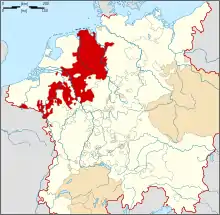
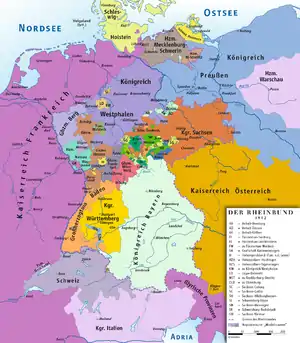
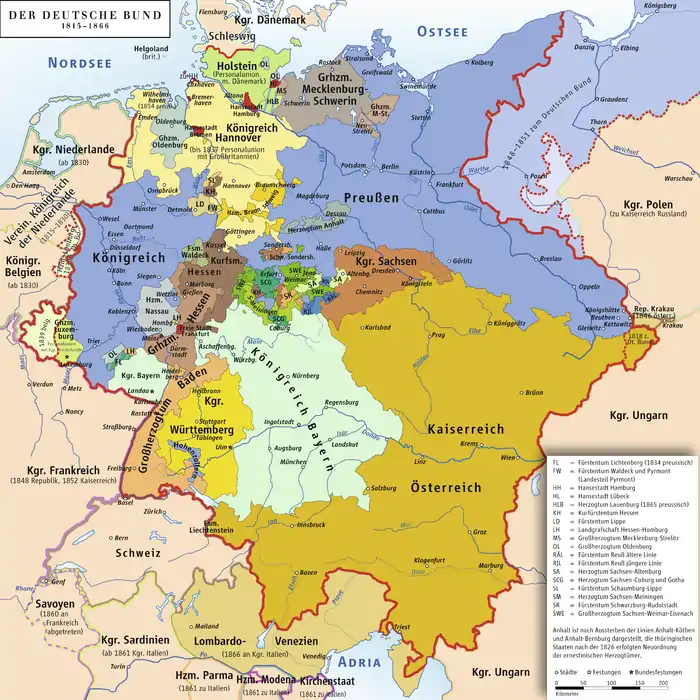
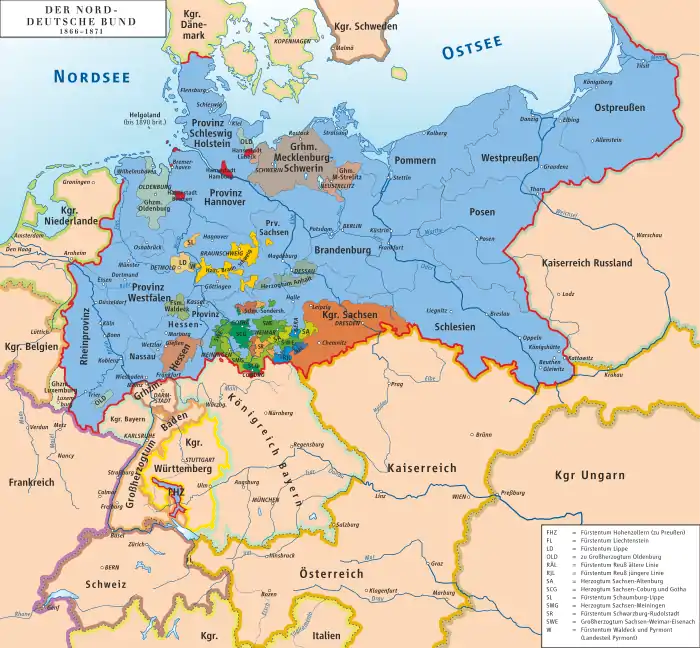
-en.png.webp)